Deep Learned Segmentations of Inflammation for Novel ⁹⁹mTc-maraciclatide Imaging of Rheumatoid Arthritis
Abstract
:1. Introduction
2. Materials and Methods
2.1. Data
2.2. Thresholding
2.3. nnU-Net
2.4. Intraobserver Variability
2.5. Dice Score
2.6. Intersection over Union (IoU)
2.7. Confusion Matrix
2.8. Crossfolding
2.9. Single Inflammation Class
2.10. ROC Curves
3. Results
3.1. Inflammation as a Single Class
3.2. ROC Curve
4. Discussion
4.1. Relative Performance of Low and High Inflammation
4.2. Imbalanced Dataset
4.3. Limitations
5. Conclusions
Author Contributions
Funding
Institutional Review Board Statement
Informed Consent Statement
Data Availability Statement
Conflicts of Interest
References
- Attipoe, L.; Chaabo, K.; Wajed, J.; Hassan, F.U.; Shivapatham, D.; Morrison, M.; Ballinger, J.; Cook, G.; Cope, A.P.; Garrood, T. Imaging neoangiogenesis in rheumatoid arthritis (INIRA): Whole-body synovial uptake of a 99mTc-labelled RGD peptide is highly correlated with power Doppler ultrasound. Ann. Rheum. Dis. 2020, 79, 1254–1255. [Google Scholar] [CrossRef] [PubMed]
- Stoel, B.C. Artificial intelligence in detecting early RA. In Seminars in Arthritis and Rheumatism; WB Saunders: Philadelphia, PA, USA, 2019; Volume 49, pp. S25–S28. [Google Scholar]
- Momtazmanesh, S.; Nowroozi, A.; Rezaei, N. Artificial intelligence in rheumatoid arthritis: Current status and future perspectives: A state-of-the-art review. Rheumatol. Ther. 2022, 9, 1249–1304. [Google Scholar] [CrossRef] [PubMed]
- More, S.; Singla, J. A Study on Automated Grading System for Early Prediction of Rheumatoid Arthritis. In Proceedings of the 2021 6th International Conference on Communication and Electronics Systems (ICCES), Coimbatre, India, 8–10 July 2021; IEEE: Piscataway, NJ, USA, 2021; pp. 1293–1300. [Google Scholar]
- Wu, M.; Wu, H.; Wu, L.; Cui, C.; Shi, S.; Xu, J.; Liu, Y.; Dong, F. A deep learning classification of metacarpophalangeal joints synovial proliferation in rheumatoid arthritis by ultrasound images. J. Clin. Ultrasound 2022, 50, 296–301. [Google Scholar] [CrossRef] [PubMed]
- Chua, I.S.; Gaziel-Yablowitz, M.; Korach, Z.T.; Kehl, K.L.; Levitan, N.A.; Arriaga, Y.E.; Jackson, G.P.; Bates, D.W.; Hassett, M. Artificial intelligence in oncology: Path to implementation. Cancer Med. 2021, 10, 4138–4149. [Google Scholar] [CrossRef] [PubMed]
- Brinjikji, W.; Abbasi, M.; Arnold, C.; Benson, J.C.; Braksick, S.A.; Campeau, N.; Carr, C.M.; Cogswell, P.M.; Klaas, J.P.; Liebo, G.B.; et al. e-ASPECTS software improves interobserver agreement and accuracy of interpretation of aspects score. Interv. Neuroradiol. 2021, 27, 781–787. [Google Scholar] [CrossRef] [PubMed]
- Zhou, Z.; Rahman Siddiquee, M.M.; Tajbakhsh, N.; Liang, J. Unet++: A nested u-net architecture for medical image segmentation. In Deep Learning in Medical Image Analysis and Multimodal Learning for Clinical Decision Support: 4th International Workshop, DLMIA 2018, and 8th International Workshop, ML-CDS 2018, Held in Conjunction with MICCAI 2018, Granada, Spain, 20 September 2018; Proceedings 4; Springer International Publishing: Berlin/Heidelberg, Germany, 2018; pp. 3–11. [Google Scholar]
- Jha, D.; Smedsrud, P.H.; Riegler, M.A.; Johansen, D.; De Lange, T.; Halvorsen, P.; Johansen, H.D. Resunet++: An advanced architecture for medical image segmentation. In Proceedings of the 2019 IEEE International Symposium on Multimedia (ISM), San Diego, CA, USA, 9–11 December 2019; IEEE: Piscataway, NJ, USA, 2019; pp. 225–2255. [Google Scholar]
- Conze, P.H.; Andrade-Miranda, G.; Singh, V.K.; Jaouen, V.; Visvikis, D. Current and emerging trends in medical image segmentation with deep learning. IEEE Trans. Radiat. Plasma Med. Sci. 2023, 7, 545–569. [Google Scholar] [CrossRef]
- Frid-Adar, M.; Diamant, I.; Klang, E.; Amitai, M.; Goldberger, J.; Greenspan, H. GAN-based synthetic medical image augmentation for increased CNN performance in liver lesion classification. Neurocomputing 2018, 321, 321–331. [Google Scholar] [CrossRef]
- Armanious, K.; Jiang, C.; Fischer, M.; Küstner, T.; Hepp, T.; Nikolaou, K.; Gatidis, S.; Yang, B. MedGAN: Medical image translation using GANs. Comput. Med. Imaging Graph. 2020, 79, 101684. [Google Scholar] [CrossRef]
- Tang, M.; Zhang, Z.; Cobzas, D.; Jagersand, M.; Jaremko, J.L. Segmentation-by-detection: A cascade network for volumetric medical image segmentation. In Proceedings of the 2018 IEEE 15th International Symposium on Biomedical Imaging (ISBI 2018), Washington, DC, USA, 4–7 April 2018; IEEE: Piscataway, NJ, USA, 2018; pp. 1356–1359. [Google Scholar]
- Dou, Q.; Yu, L.; Chen, H.; Jin, Y.; Yang, X.; Qin, J.; Heng, P.A. 3D deeply supervised network for automated segmentation of volumetric medical images. Med. Image Anal. 2017, 41, 40–54. [Google Scholar] [CrossRef]
- Alarcón-Paredes, A.; Guzmán-Guzmán, I.P.; Hernández-Rosales, D.E.; Navarro-Zarza, J.E.; Cantillo-Negrete, J.; Cuevas-Valencia, R.E.; Alonso, G.A. Computer-aided diagnosis based on hand thermal, RGB images, and grip force using artificial intelligence as screening tool for rheumatoid arthritis in women. Med. Biol. Eng. Comput. 2021, 59, 287–300. [Google Scholar] [CrossRef]
- Mate, G.S.; Kureshi, A.K.; Singh, B.K. An efficient CNN for hand X-ray classification of rheumatoid arthritis. J. Healthc. Eng. 2021, 2021, 6712785. [Google Scholar] [CrossRef] [PubMed]
- Üreten, K.; Erbay, H.; Maraş, H.H. Detection of rheumatoid arthritis from hand radiographs using a convolutional neural network. Clin. Rheumatol. 2020, 39, 969–974. [Google Scholar] [CrossRef] [PubMed]
- Reed, M.; Le Souëf, T.; Rampono, E. Pilot study of a machine-learning tool to assist in the diagnosis of hand arthritis. Intern. Med. J. 2022, 52, 959–967. [Google Scholar] [CrossRef] [PubMed]
- Tkachenko, M.; Malyuk, M.; Holmanyuk, A.; Liubimov, N. Label Studio: Data Labeling Software. 2022. Available online: https://github.com/heartexlabs/label-studio (accessed on 16 February 2023).
- Isensee, F.; Jaeger, P.F.; Kohl, S.A.; Petersen, J.; Maier-Hein, K.H. nnU-Net: A self-configuring method for deep learning-based biomedical image segmentation. Nat. Methods 2021, 18, 203–211. [Google Scholar] [CrossRef] [PubMed]
- Ronneberger, O.; Fischer, P.; Brox, T. U-net: Convolutional networks for biomedical image segmentation. In Medical Image Computing and Computer-Assisted Intervention–MICCAI 2015: 18th International Conference, Munich, Germany, 5–9 October 2015; Proceedings, Part III 18; Springer International Publishing: Berlin/Heidelberg, Germany, 2015; pp. 234–241. [Google Scholar]
- Ostmeier, S.; Axelrod, B.; Bertels, J.; Isensee, F.; Lansberg, M.G.; Christensen, S.; Albers, G.W.; Li, L.J.; Heit, J.J. Evaluation of Medical Image Segmentation Models for Uncertain, Small or Empty Reference Annotations. arXiv 2022, arXiv:2209.13008. [Google Scholar]
- Cardoso, M.J.; Li, W.; Brown, R.; Ma, N.; Kerfoot, E.; Wang, Y.; Murrey, B.; Myronenko, A.; Zhao, C.; Yang, D.; et al. Monai: An open-source framework for deep learning in healthcare. arXiv 2022, arXiv:2211.02701. [Google Scholar]
- Andersen, J.K.H.; Pedersen, J.S.; Laursen, M.S.; Holtz, K.; Grauslund, J.; Savarimuthu, T.R.; Just, S.A. Neural networks for automatic scoring of arthritis disease activity on ultrasound images. RMD Open 2019, 5, e000891. [Google Scholar] [CrossRef]
- Tripoliti, E.E.; Fotiadis, D.I.; Argyropoulou, M. Automated segmentation and quantification of inflammatory tissue of the hand in rheumatoid arthritis patients using magnetic resonance imaging data. Artif. Intell. Med. 2007, 40, 65–85. [Google Scholar] [CrossRef]
- Lin, T.Y.; Goyal, P.; Girshick, R.; He, K.; Dollár, P. Focal loss for dense object detection. In Proceedings of the IEEE International Conference on Computer Vision, Venice, Italy, 22–29 October 2017; pp. 2980–2988. [Google Scholar]
- Salehi, S.S.M.; Erdogmus, D.; Gholipour, A. Tversky loss function for image segmentation using 3D fully convolutional deep networks. In International Workshop on Machine Learning in Medical Imaging; Springer International Publishing: Cham, Switzerland, 2017; pp. 379–387. [Google Scholar]
- Goodfellow, I.; Pouget-Abadie, J.; Mirza, M.; Xu, B.; Warde-Farley, D.; Ozair, S.; Courville, A.; Bengio, Y. Generative adversarial networks. Commun. ACM 2020, 63, 139–144. [Google Scholar] [CrossRef]
- Ho, J.; Jain, A.; Abbeel, P. Denoising diffusion probabilistic models. Adv. Neural Inf. Process. Syst. 2020, 33, 6840–6851. [Google Scholar]
- Fetty, L.; Bylund, M.; Kuess, P.; Heilemann, G.; Nyholm, T.; Georg, D.; Löfstedt, T. Latent space manipulation for high-resolution medical image synthesis via the StyleGAN. Z. Med. Phys. 2020, 30, 305–314. [Google Scholar] [CrossRef]
- Zhao, H.; Li, H.; Cheng, L. Synthesizing filamentary structured images with GANs. arXiv 2017, arXiv:1706.02185. [Google Scholar]
- Guan, Q.; Chen, Y.; Wei, Z.; Heidari, A.A.; Hu, H.; Yang, X.H.; Zheng, J.; Zhou, Q.; Chen, H.; Chen, F. Medical image augmentation for lesion detection using a texture-constrained multichannel progressive GAN. Comput. Biol. Med. 2022, 145, 105444. [Google Scholar] [CrossRef]
- Qasim, A.B.; Ezhov, I.; Shit, S.; Schoppe, O.; Paetzold, J.C.; Sekuboyina, A.; Kofler, F.; Lipkova, J.; Li, H.; Menze, B. Red-GAN: Attacking class imbalance via conditioned generation. Yet another medical imaging perspective. In Proceedings of the Third Conference on Medical Imaging with Deep Learning, PMLR, Montreal, QC, Canada, 6–8 July 2020; pp. 655–668. [Google Scholar]
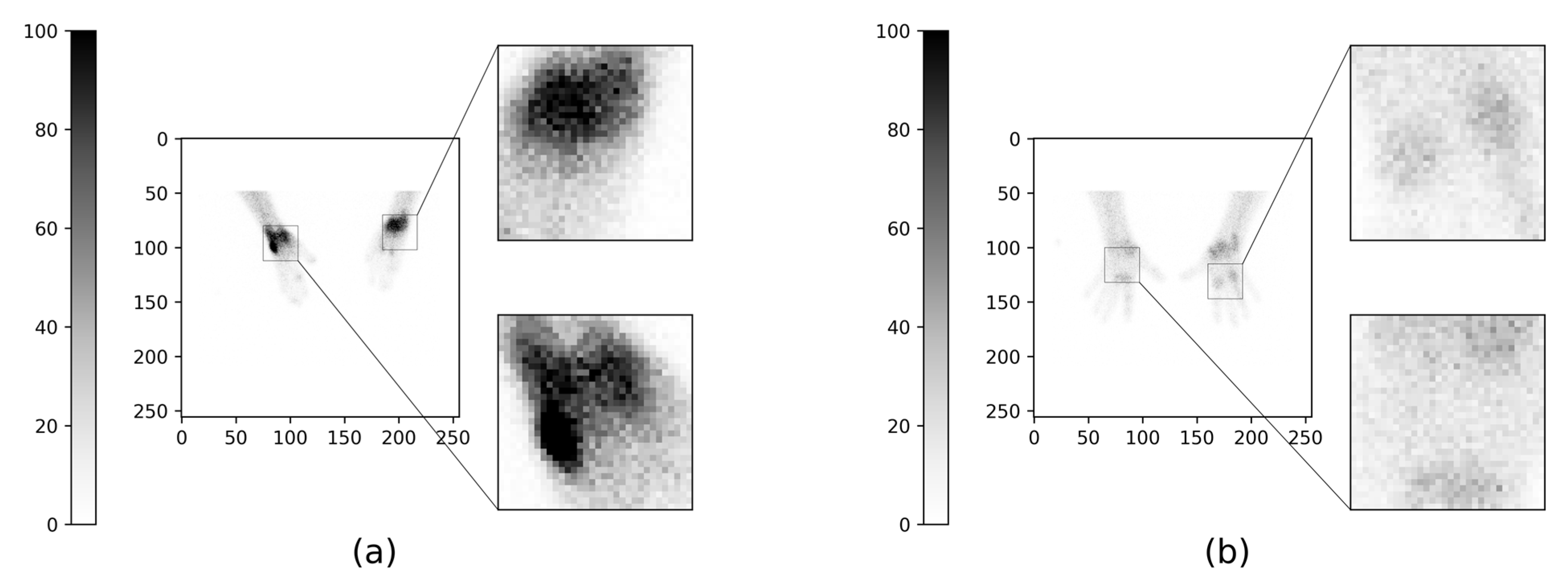
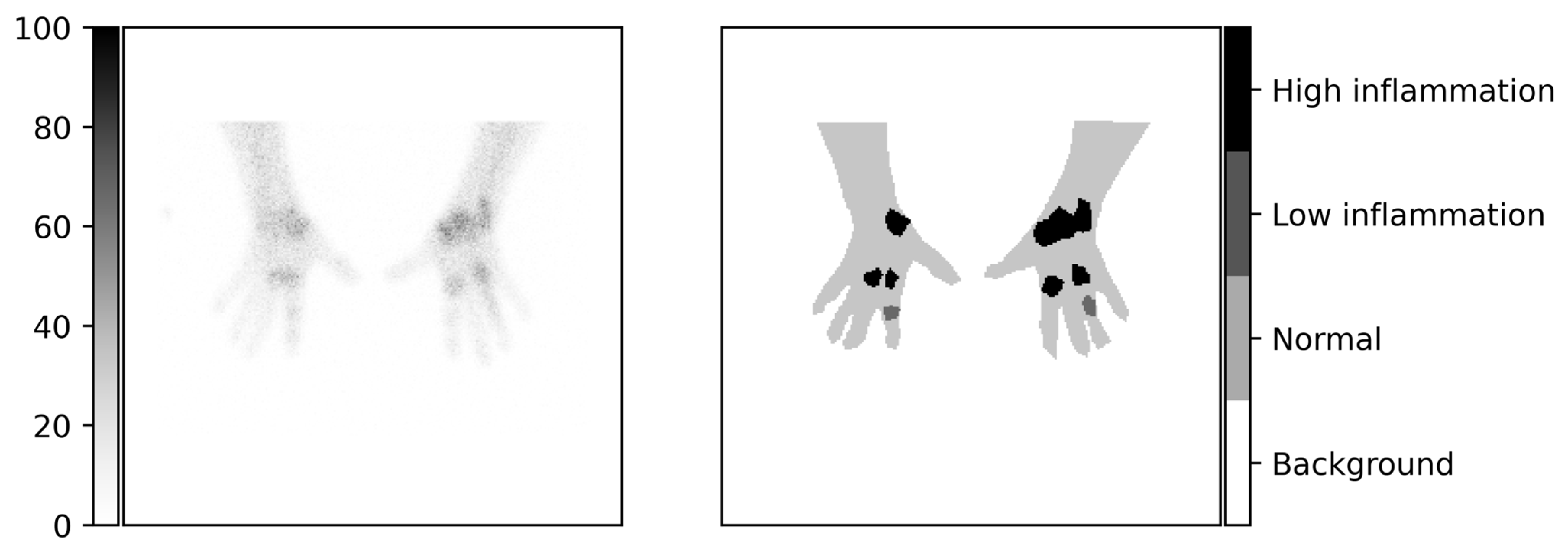
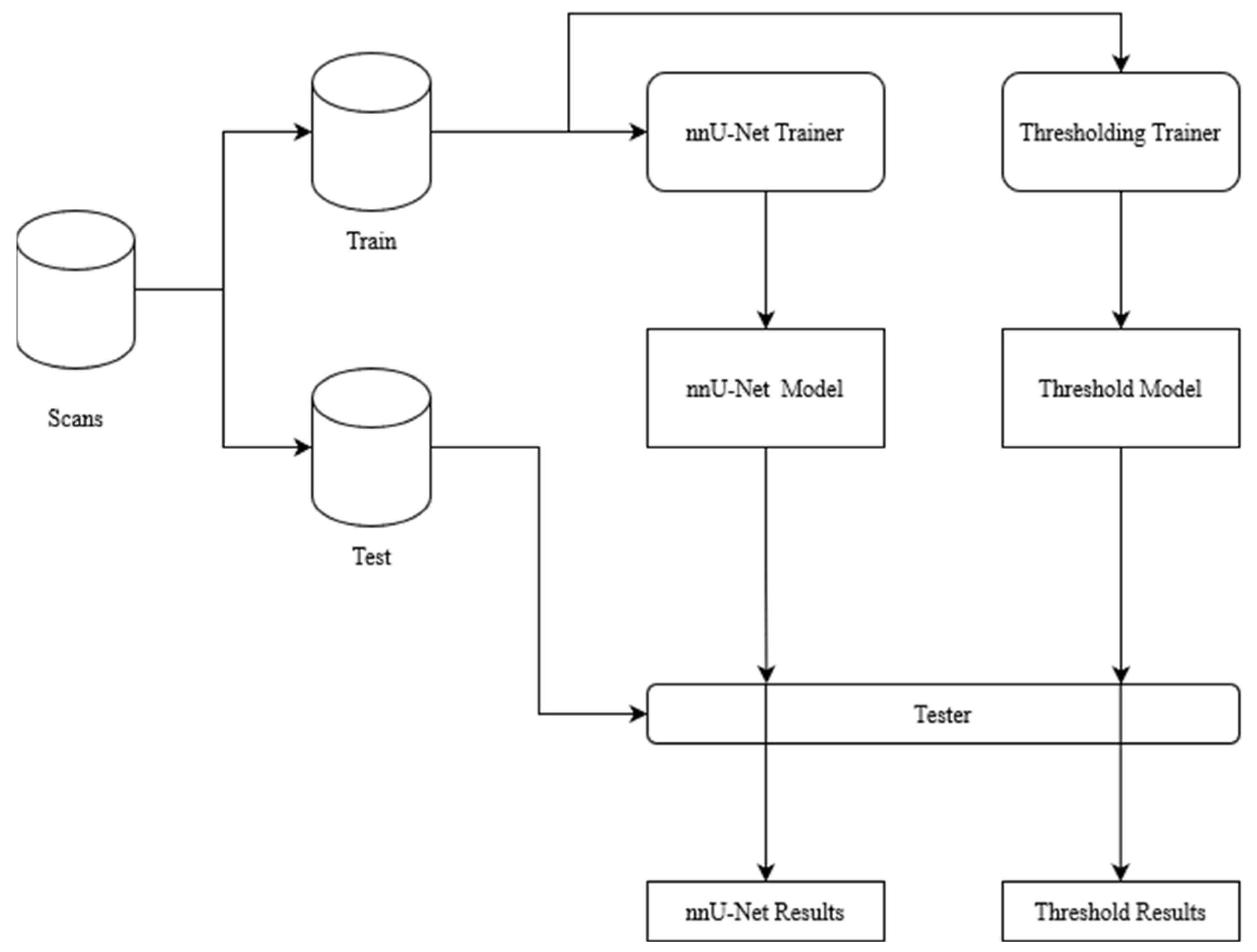
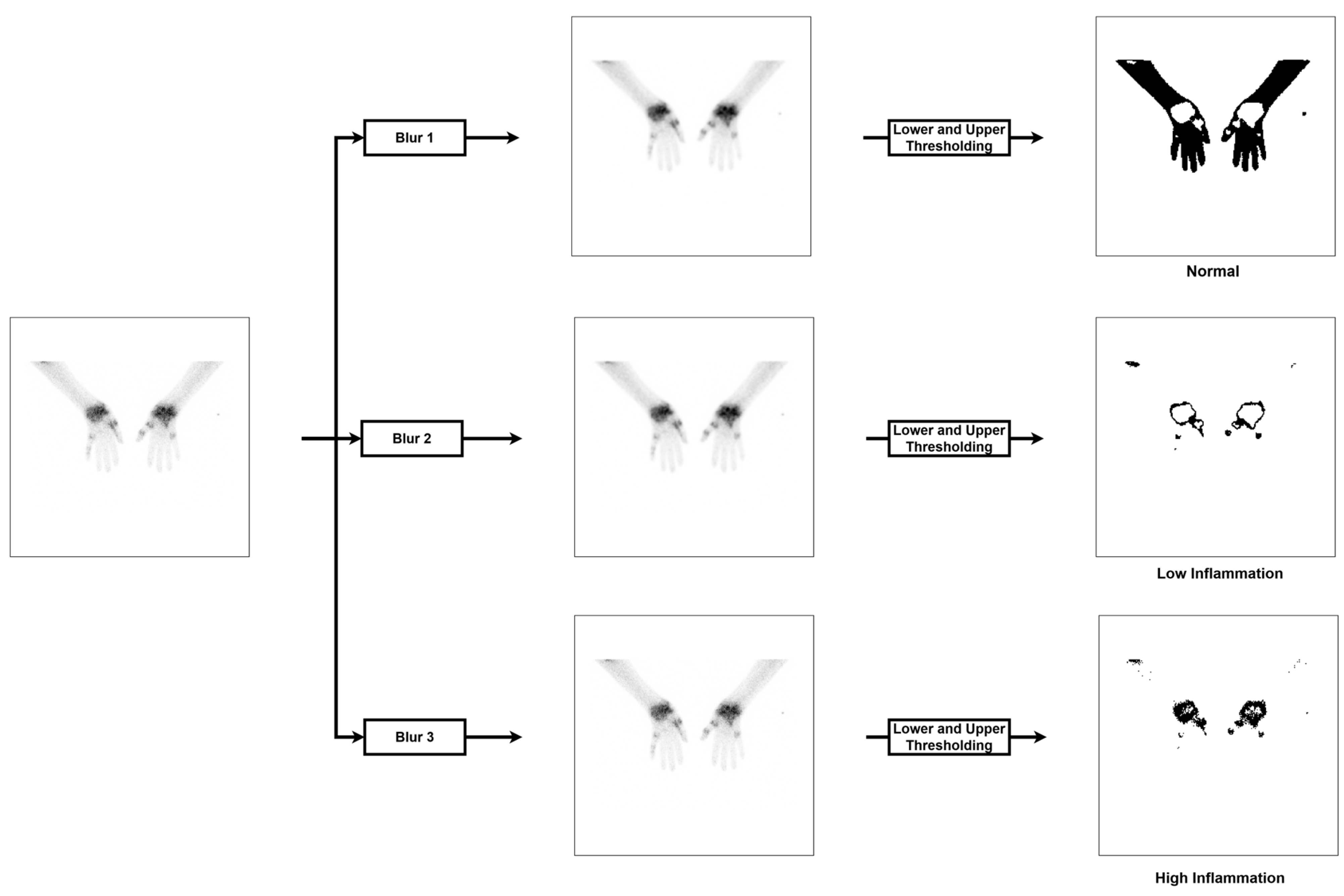
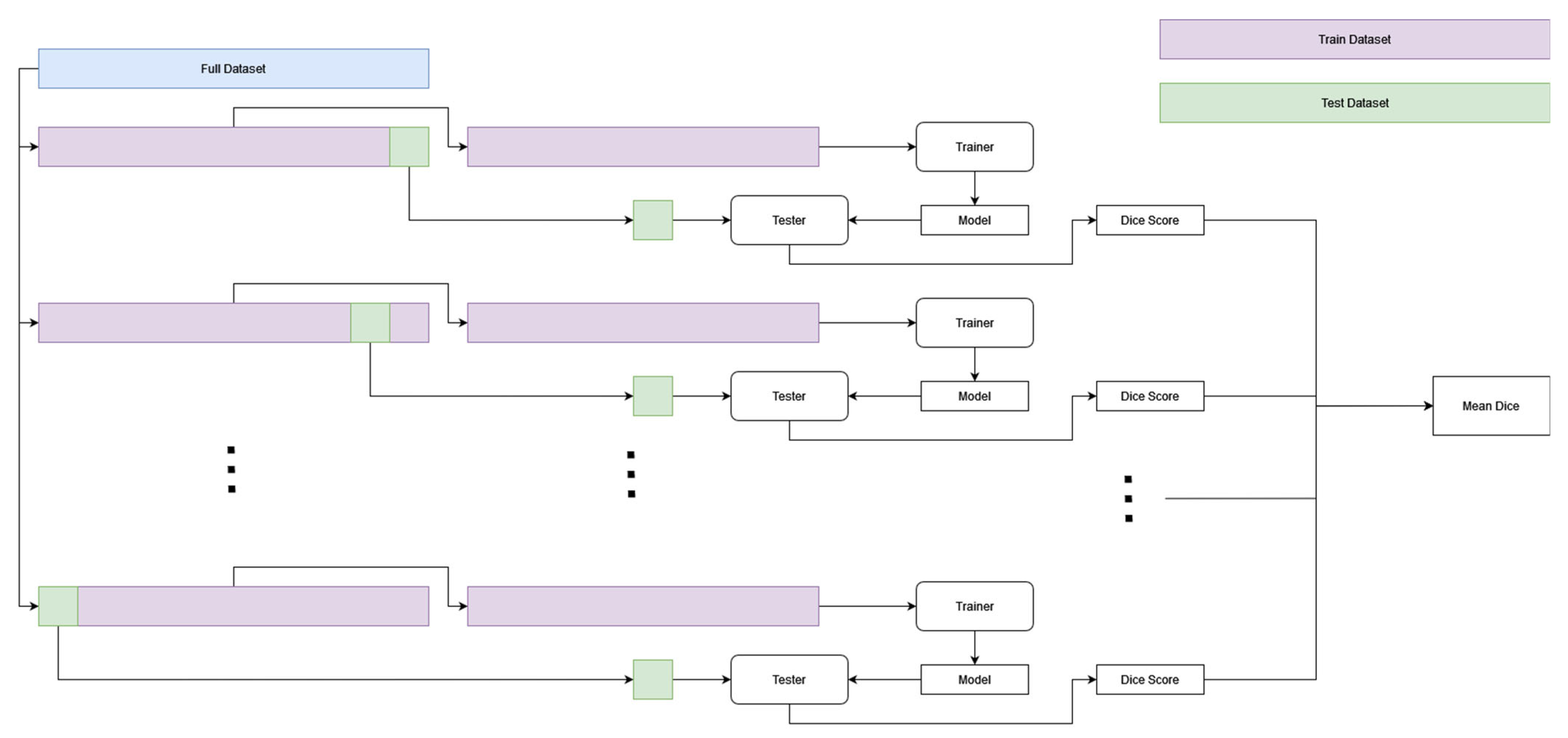

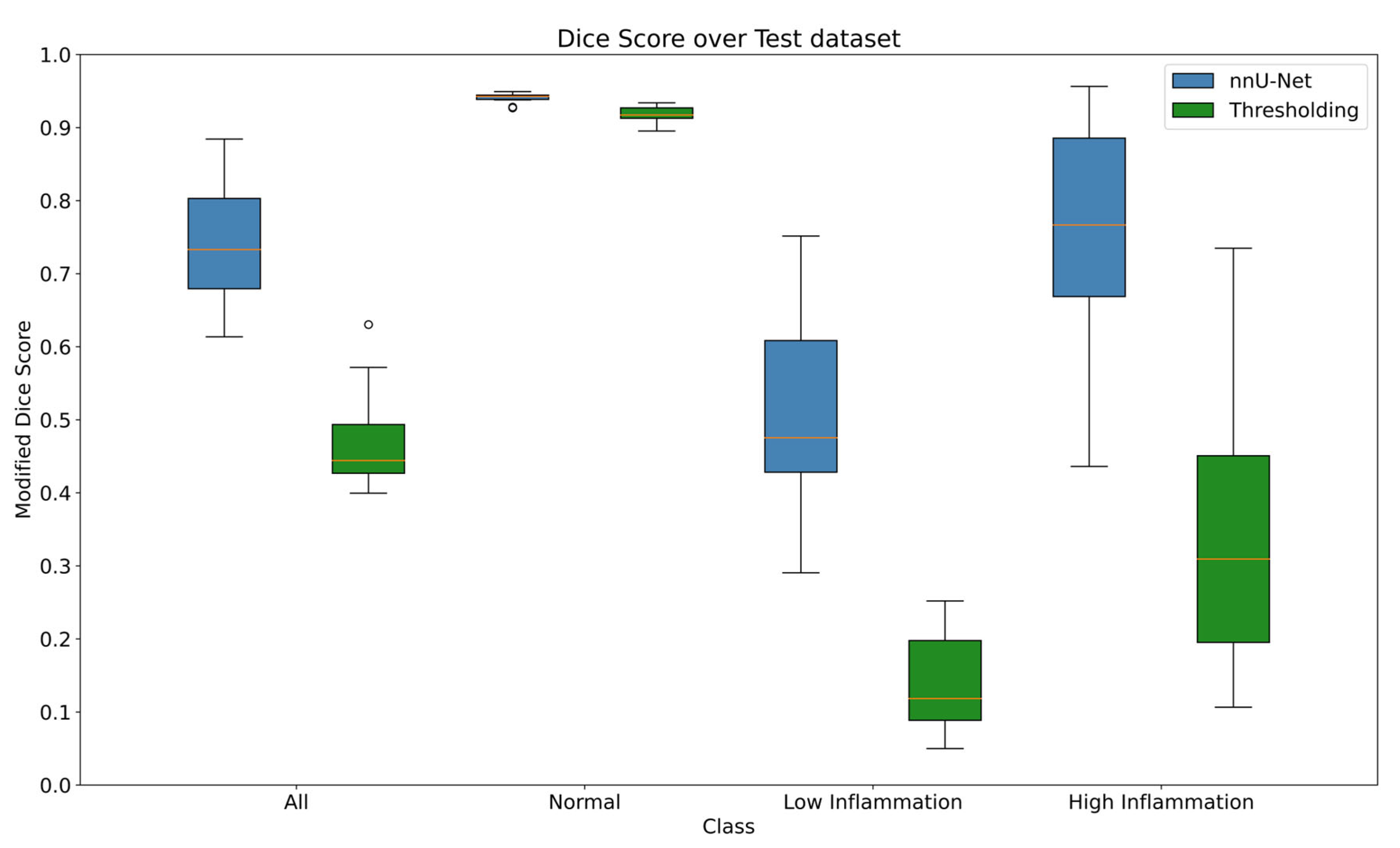
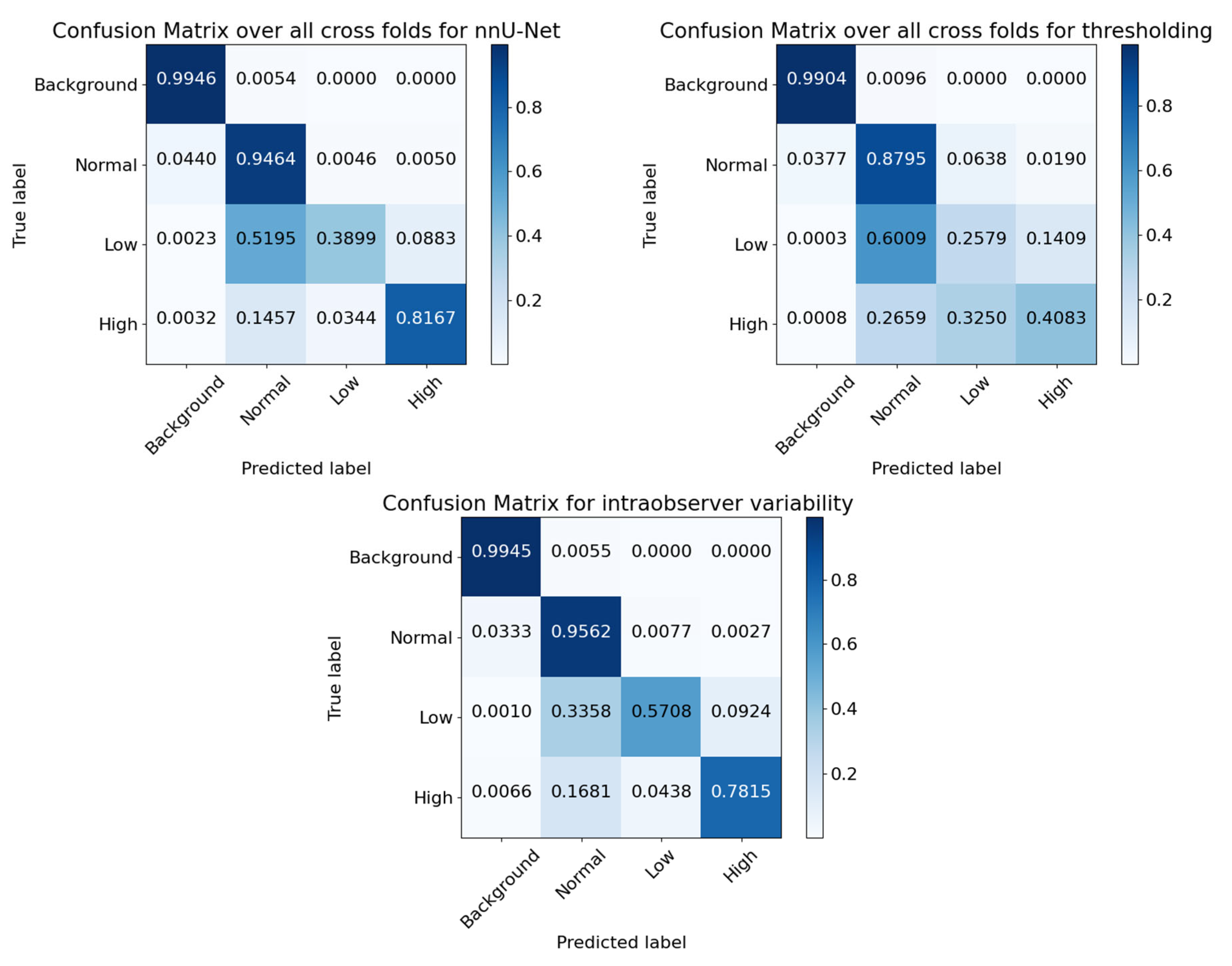
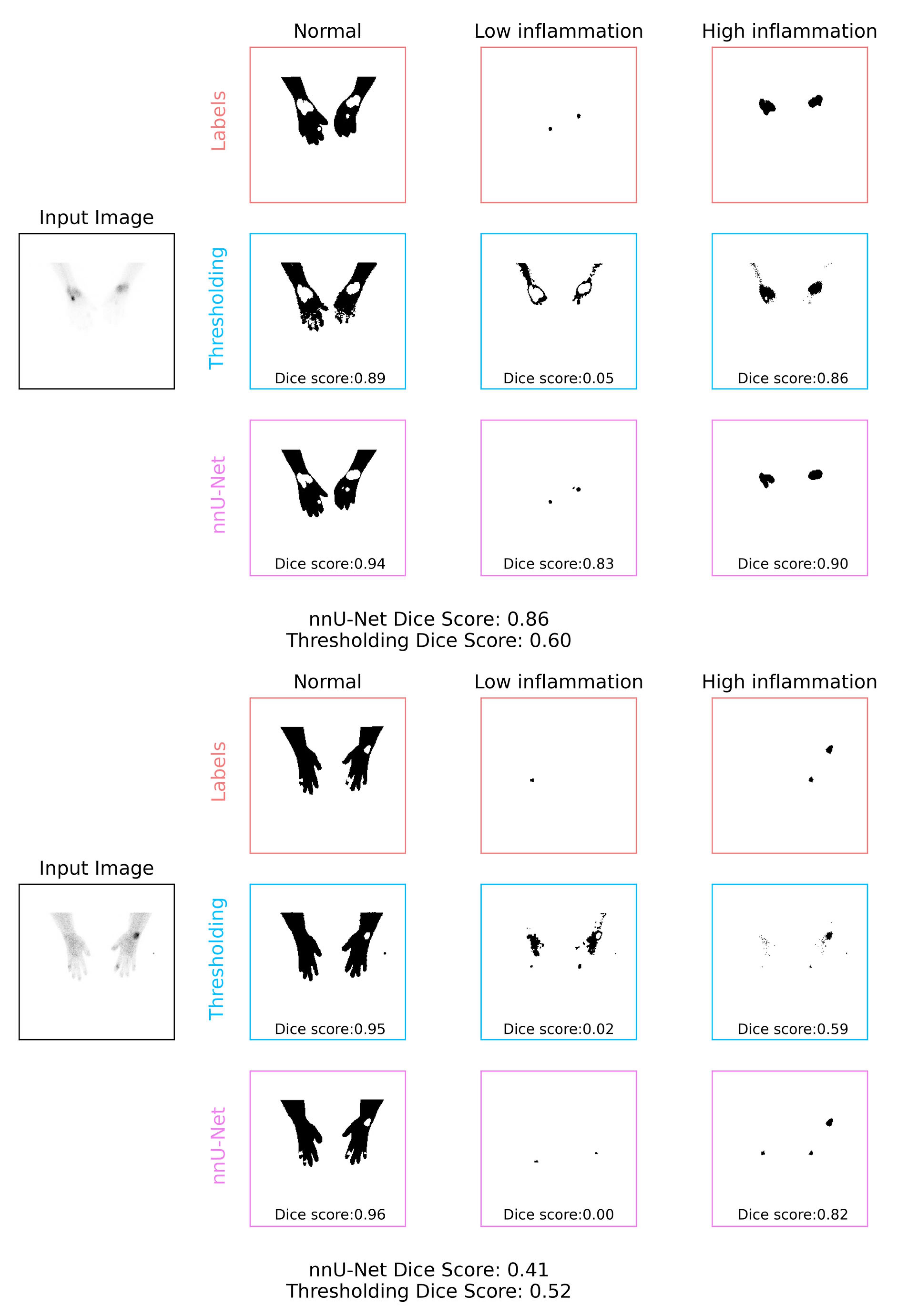
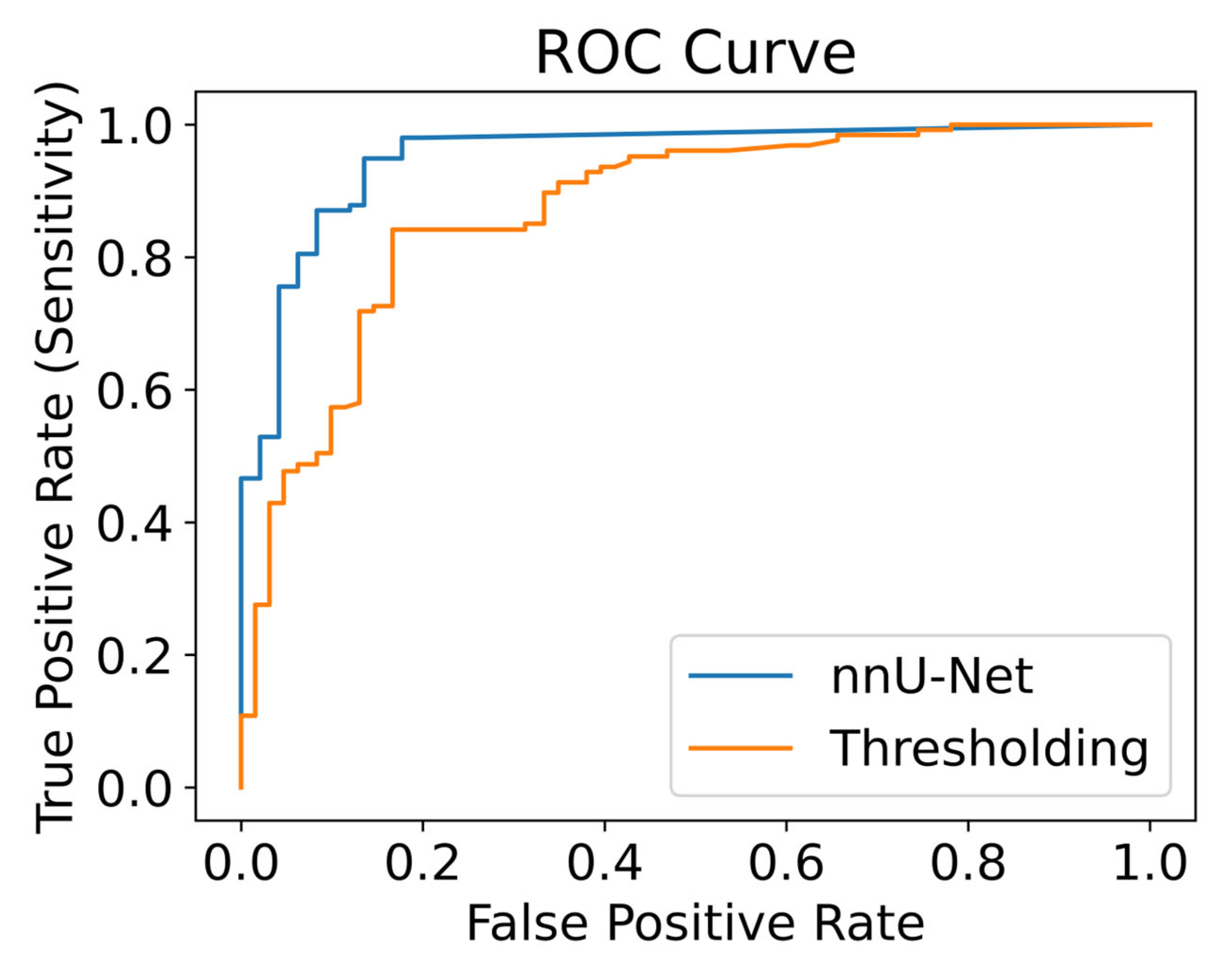
| Crossfold | Thresholding Model | nnU-Net Model | ||||||
|---|---|---|---|---|---|---|---|---|
| Normal | Low | High | All | Normal | Low | High | All | |
| 1 | 0.93 | 0.2 | 0.28 | 0.47 | 0.95 | 0.61 | 0.72 | 0.76 |
| 2 | 0.93 | 0.08 | 0.49 | 0.5 | 0.94 | 0.38 | 0.8 | 0.71 |
| 3 | 0.91 | 0.12 | 0.32 | 0.45 | 0.94 | 0.43 | 0.65 | 0.67 |
| 4 | 0.91 | 0.19 | 0.11 | 0.4 | 0.95 | 0.46 | 0.44 | 0.61 |
| 5 | 0.92 | 0.05 | 0.33 | 0.43 | 0.94 | 0.64 | 0.93 | 0.83 |
| 6 | 0.92 | 0.11 | 0.68 | 0.57 | 0.94 | 0.5 | 0.84 | 0.76 |
| 7 | 0.91 | 0.24 | 0.73 | 0.63 | 0.94 | 0.61 | 0.9 | 0.82 |
| 8 | 0.92 | 0.25 | 0.13 | 0.44 | 0.93 | 0.29 | 0.64 | 0.62 |
| 9 | 0.93 | 0.11 | 0.17 | 0.4 | 0.94 | 0.75 | 0.96 | 0.88 |
| 10 | 0.90 | 0.08 | 0.3 | 0.43 | 0.93 | 0.43 | 0.73 | 0.7 |
| Mean | 0.92 ± 0.01 | 0.14 ± 0.07 | 0.35 ± 0.21 | 0.47 ± 0.08 | 0.94 ± 0.01 | 0.51 ± 0.14 | 0.76 ± 0.16 | 0.74 ± 0.09 |
| Crossfold | Thresholding Model | nnU-Net Model |
|---|---|---|
| 1 | 0.34 | 0.73 |
| 2 | 0.5 | 0.68 |
| 3 | 0.39 | 0.67 |
| 4 | 0.2 | 0.66 |
| 5 | 0.26 | 0.83 |
| 6 | 0.68 | 0.82 |
| 7 | 0.72 | 0.83 |
| 8 | 0.28 | 0.5 |
| 9 | 0.21 | 0.89 |
| 10 | 0.42 | 0.63 |
| Mean | 0.4 ± 0.18 | 0.72 ± 0.12 |
Disclaimer/Publisher’s Note: The statements, opinions and data contained in all publications are solely those of the individual author(s) and contributor(s) and not of MDPI and/or the editor(s). MDPI and/or the editor(s) disclaim responsibility for any injury to people or property resulting from any ideas, methods, instructions or products referred to in the content. |
© 2023 by the authors. Licensee MDPI, Basel, Switzerland. This article is an open access article distributed under the terms and conditions of the Creative Commons Attribution (CC BY) license (https://creativecommons.org/licenses/by/4.0/).
Share and Cite
Cobb, R.; Cook, G.J.R.; Reader, A.J. Deep Learned Segmentations of Inflammation for Novel ⁹⁹mTc-maraciclatide Imaging of Rheumatoid Arthritis. Diagnostics 2023, 13, 3298. https://doi.org/10.3390/diagnostics13213298
Cobb R, Cook GJR, Reader AJ. Deep Learned Segmentations of Inflammation for Novel ⁹⁹mTc-maraciclatide Imaging of Rheumatoid Arthritis. Diagnostics. 2023; 13(21):3298. https://doi.org/10.3390/diagnostics13213298
Chicago/Turabian StyleCobb, Robert, Gary J. R. Cook, and Andrew J. Reader. 2023. "Deep Learned Segmentations of Inflammation for Novel ⁹⁹mTc-maraciclatide Imaging of Rheumatoid Arthritis" Diagnostics 13, no. 21: 3298. https://doi.org/10.3390/diagnostics13213298
APA StyleCobb, R., Cook, G. J. R., & Reader, A. J. (2023). Deep Learned Segmentations of Inflammation for Novel ⁹⁹mTc-maraciclatide Imaging of Rheumatoid Arthritis. Diagnostics, 13(21), 3298. https://doi.org/10.3390/diagnostics13213298






